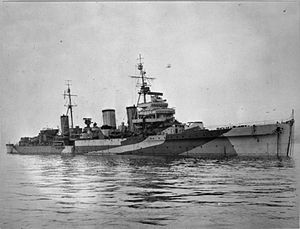HMS Enterprise (D52)

Enterprise in November 1943
|
|
| History | |
|---|---|
|
|
|
| Name: | HMS Enterprise |
| Builder: | John Brown Shipbuilding & Engineering Company Ltd. (Clydebank, Scotland) |
| Yard number: | 484 |
| Laid down: | 28 June 1918 |
| Launched: | 23 December 1919 |
| Commissioned: | 7 April 1926 |
| Decommissioned: | 13 January 1946 |
| Reclassified: | In reserve between 5 January 1945, but was used for trooping duties postwar. |
| Identification: | Pennant number: D52 |
| Motto: |
|
| Honours and awards: |
|
| Fate: | |
| Badge: | On a field red, a lion rampant under a star silver. |
| General characteristics | |
| Class and type: | Emerald-class light cruiser |
| Displacement: | 7,580 long tons (7,700 t) |
| Tons burthen: | 9,435 long tons (9,586 t) |
| Length: | 570 ft (170 m) |
| Beam: | 54 ft 6 in (16.61 m) |
| Draught: | 16 ft 6 in (5.03 m) |
| Installed power: | 80,000 shp (59,700 kW) |
| Propulsion: |
|
| Speed: | 33 kn (61 km/h; 38 mph) |
| Range: | |
| Capacity: | 1,746 tons fuel oil |
| Complement: | 572 officers and enlisted |
| Armament: |
|
| Armour: | |
| Aircraft carried: | 1 × Seafox |
| Aviation facilities: | 1 × catapult (later removed) |
HMS Enterprise was one of two Emerald-class light cruisers of the Royal Navy. She was built by John Brown Shipbuilding & Engineering Company Ltd., with the keel being laid down on 28 June 1918. She was launched on 23 December 1919, and commissioned on 7 April 1926. She was the 14th ship to serve with the Royal Navy to carry the name Enterprise, a name which is still used in the Royal Navy today.
In the early 1930s, Enterprise was fitted with a prototype twin 6" turret in place of her two forward single mounts; and with the trials proving successful it was retained for the rest of her service career. This turret was later worked into the design of the Leander, Amphion and Arethusa classes. The turret installation occupied less space than the superimposed 'A' and 'B' guns of Emerald, therefore the bridge was placed further forward. The bridge was of a new design, being a single block topped by a director tower, rather than the traditional platforms built around the foremast and wheelhouse topped with a spotting top. This design of bridge would appear in the County-class cruisers.
After several months in home waters, Enterprise served with the British 4th Cruiser Squadron in the East Indies her first commission ending in December 1928. Her first commission was remarkable mostly for its culmination and the events that took place between 19 September and 10 December 1928 which are outlined under the history of the Enterprise Cup, a rugby union trophy that is still contested to this day in Kenya. Enterprise undertook several subsequent commissions on the East Indies Station, until she returned home and was reduced to care and maintenance on 4 July 1934, followed by a major refit. She returned to the East Indies in January 1936.
On the afternoon of 4 May 1936, Enterprise departed Djibouti in French Somaliland carrying the Emperor of Ethiopia, Haile Selassie – who had fled there as Italy completed its conquest of Ethiopia in the Second Italo-Ethiopian War – and transported him to Haifa in the British Mandate of Palestine, beginning his five-year period in exile in England at Fairfield House, Bath before he returned to Ethiopia in 1941.
...
Wikipedia
